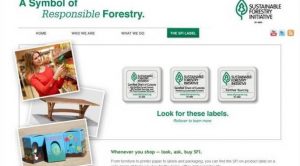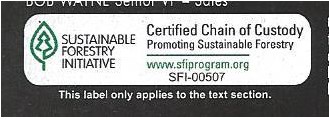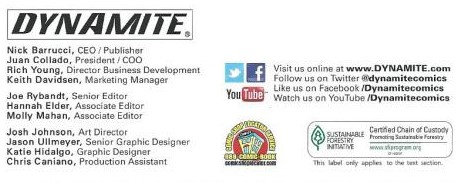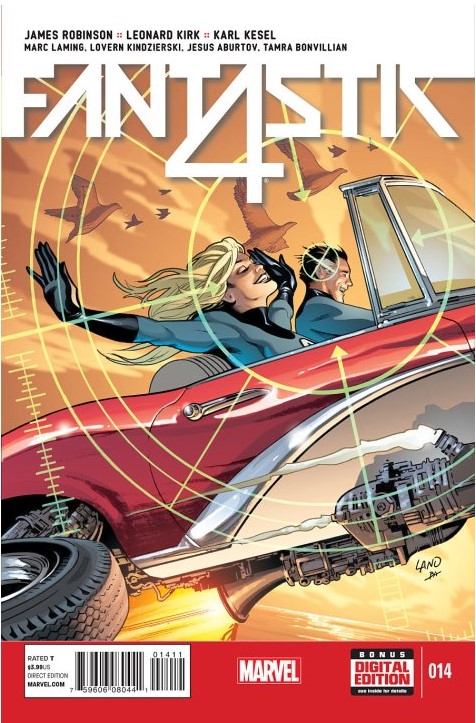Attentive readers may notice the Sustainable Forestry Initiative certification label printed inside the comic books published by DC Comics and Dynamite Entertainment. The Sustainable Forestry Initiative (SFI) is a forest certification system provided by the non-profit organization SFI, Inc. Forest certification systems provided by third-party organizations like SFI, Inc. should give consumers confidence that the paper products they are purchasing come from suppliers who follow good environmental and social practices: protecting biodiversity and water quality, the quick replanting of trees, and working with the local communities affected by logging, among others.
However, some environmental organizations are critical of the SFI system, raising questions about whether the SFI label used by DC and Dynamite should assure readers that the paper in their comics was created in an environmentally friendly manner. Also, other comics publishers are not as transparent about their paper sourcing, and were unresponsive to inquiries from Nothing But Comics about the certification systems used for their paper.

According to its website, the SFI certification program offers three types of labels: a “Certified Chain of Custody” label that tracks the use of fiber from certified forests, certified sourcing and recycled materials (this label provides percentages that disclose the amount of fiber in the paper product from each of these three sources); another “Certified Chain of Custody” label that tracks the use of fiber from certified forests, certified sourcing, and post-consumer recycled materials – to use this label, an organization must meet a minimum threshold of 70% certified forest materials or recycled material; and a “Certified Sourcing Label” that “does not make claims about certified forest content, but tells you that fiber in a product comes from a company that is certified to the SFI fiber sourcing standard, or comes from recycled content, or from a certified forest. All fiber must be from non-controversial sources.”
Of these three labels, both DC Comics and Dynamite Entertainment use the second, suggesting that at least 70% of the fiber in their comic books comes from certified forests or recycled material. But how much confidence should this SFI label give consumers? The SFI, Inc. website states that the organization “manages the largest single forest certification standard in the world” and that it “improves forest management across the United States and Canada, and strengthens procurement globally through chain-of-custody certification and responsible fiber sourcing.” The website also notes that in 2011, the international non-profit organization the Programme for the Endorsement of Forest Certification (PEFC) “endorsed the SFI forest standard after a thorough application, independent assessments and a public review process.”

PEFC is one of the two largest international forest certification organizations; the other is the Forest Stewardship Council (FSC). Both organizations have been criticized by some environmental groups for questionable certifications. Given this criticism, of what value are third-party forest certification systems to comics readers? Nothing But Comics contacted two environmental non-profit organizations – Greenpeace and the Green Press Initiative – to get their input on the importance of forest certification systems.
Judy Rodrigues, a Senior Forest Campaigner with Greenpeace, explained why third-party forest certifications are important: “Certification schemes use forest management standards and trademark/labeling policies (or in the case of the Programme for the Endorsement of Forest Certification (PEFC) it endorses national schemes against its international requirements) to ensure its labelled wood/forests products are derived from well-managed forests. The certification schemes then work with assurance systems to accredited third-party auditors that verify whether forest and chain-of-custody (for checks along the supply chain) managers are compliant with its standards and thus can use their labels.”
Rodrigues indicated that although FSC faces challenges, Greenpeace recognizes FSC as the best forest certification system: “However, not all certification systems are created equal and this is why Greenpeace recognizes the Forest Stewardship Council (FSC) system and label as the best system to ensure that buying timber and paper products comes from environmentally and socially responsible sources. Note, FSC does face challenges but Greenpeace believes that it contains a framework, as well as principles and criteria, that can guarantee socially and ecologically responsible practices if implemented correctly. Other ‘fake’ systems like PEFC, SFI (Sustainable Forestry Initiative) and MTCS (Malaysian Timber Certification Scheme) lack robust requirements to protect social and ecological values.”

The Green Press Initiative works with publishers to preserve natural resources and endangered forests. According to Todd Pollak, Program Manager for the Green Press Initiative, the organization also endorses the FSC forest certification system: “Green Press Initiative encourages all publishers to source any virgin paper from well-managed forests. We strongly support the use of paper certified by the Forest Stewardship Council (FSC) as it offers the greatest protections for critical ecosystems and minimizes social impacts. Currently FSC is the only certification system that offers the greatest protections for High Conservation Value Forests, prevents the conversion of natural forests into plantations, minimizes the use of chemical fertilizers and pesticides and requires a consensus solution when conflicts arise with local communities affected by logging. Using FSC certified papers in conjunction with maximizing the use of recycled fiber is the best way for any publisher to minimize their environmental impacts.”
The environmental groups we contacted preferred the FSC system, but why do DC Comics and Dynamite Entertainment choose to use paper certified by SFI? DC Comics and Dynamite Entertainment did not respond to multiple inquiries from Nothing But Comics about why they choose to use the SFI system for their paper.

Although DC and Dynamite display SFI labels in their comics, it is not clear what forest certification systems – if any – are used by other publishers. Marvel Comics did not respond to multiple inquiries from Nothing But Comics about the forest certification system for its paper. However, Marvel’s parent company, the Walt Disney Company, has a paper sourcing policy that requires the company and its affiliates to “maximize the use of wood fiber sourced from forestry operations certified by the Forest Stewardship Council or an equivalent forest certification scheme.” Given this policy, Marvel likely uses the FSC system for its paper, although no FSC certification label or other paper sourcing information appears in its comics.
Nothing But Comics made multiple inquires to other publishers (Avatar Press, Boom!Studios, Dark Horse Comics, IDW, Image Comics, and Valiant) about the forest certification systems used for their paper, but none responded.
Comics readers concerned about the environmental and social issues related to paper sourcing should be aware of the forest certification systems used by comics publishers. Only two publishers provide clear information about their certification systems (both use a SFI system disfavored by some environmental groups), while other publishers provide no information in their comics about their certification systems and are non-responsive to questions about such systems.








